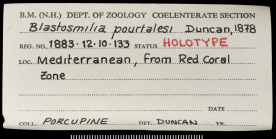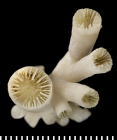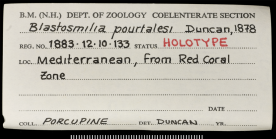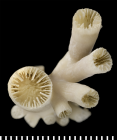WoRMS taxon details
Pourtalosmilia Duncan, 1884
135099 (urn:lsid:marinespecies.org:taxname:135099)
accepted
Genus
Blastosmilia pourtalesi Duncan, 1878 accepted as Pourtalosmilia anthophyllites (Ellis & Solander, 1786) (type by monotypy)
Blastosmilia Duncan, 1878 · unaccepted > junior subjective synonym
- Species Pourtalosmilia anthophyllites (Ellis & Solander, 1786)
- Species Pourtalosmilia conferta Cairns, 1977
- Species Pourtalosmilia dumosa Alcock, 1902 accepted as Goniocorella dumosa (Alcock, 1902) (unaccepted > superseded combination, basionym)
marine, fresh, terrestrial
recent only
Duncan PM (1884) A revision of the families and genera of the sclerodermic Zoantharia, Ed. & H., or Madreporaria (M. Rugosa excepted). Journal of the Linnean Society of London, 18: 1-204. [details]
Status Replacement name (nom. substitutum) for Blastosmilia Duncan 1878, a junior homonym of Blastosmilia Etallon, 1859.
Depth range 25-300 m
Homonymy Replacement name for Blastosmilia Duncan, 1878, a junior homonym of Blastosmilia Etallon, 1859
Status Replacement name (nom. substitutum) for Blastosmilia Duncan 1878, a junior homonym of Blastosmilia Etallon, 1859. [details]
Depth range 25-300 m
Depth range 25-300 m [details]
Homonymy Replacement name for Blastosmilia Duncan, 1878, a junior homonym of Blastosmilia Etallon, 1859
Homonymy Replacement name for Blastosmilia Duncan, 1878, a junior homonym of Blastosmilia Etallon, 1859 [details]
Hoeksema, B. W.; Cairns, S. (2024). World List of Scleractinia. Pourtalosmilia Duncan, 1884. Accessed through: World Register of Marine Species at: https://www.marinespecies.org/aphia.php?p=taxdetails&id=135099 on 2024-04-18
Date
action
by
2006-09-27 07:06:07Z
changed
Martinez, Olga
![]() The webpage text is licensed under a Creative Commons Attribution 4.0 License
The webpage text is licensed under a Creative Commons Attribution 4.0 License
original description
Duncan PM (1884) A revision of the families and genera of the sclerodermic Zoantharia, Ed. & H., or Madreporaria (M. Rugosa excepted). Journal of the Linnean Society of London, 18: 1-204. [details]
original description (of Blastosmilia Duncan, 1878) Duncan PM. (1878). A Description of the Madreporaria dredged up during the Expeditions of H.M.S. Porcupine' in 1869 and 1870. – Part. II. <em>Transactions of the Zoological Society of London.</em> 10: 235-249, pls. 43-45., available online at https://doi.org/10.1111/j.1096-3642.1873.tb00560.x [details]
context source (Hexacorallia) Fautin, Daphne G. (2013). Hexacorallians of the World. (look up in IMIS) [details]
basis of record Cairns, S.D., Hoeksema, B.W., and J. van der Land, 2001. Scleractinia, <B><I>in</I></B>: Costello, M.J. <i>et al.</i> (Ed.) (2001). <i>European register of marine species: a check-list of the marine species in Europe and a bibliography of guides to their identification. Collection Patrimoines Naturels,</i> 50: pp. 109-110 (look up in IMIS) [details]
additional source Neave, Sheffield Airey. (1939-1996). Nomenclator Zoologicus vol. 1-10 Online. <em>[Online Nomenclator Zoologicus at Checklistbank. Ubio link has gone].</em> , available online at https://www.checklistbank.org/dataset/126539/about [details]
additional source Cairns, S.D., R. Baron-Szabo, A.F. Budd, B. Lathuilière, E. Roniewicz, J. Stolarski & K.G. Johnson. (2010). Corallosphere. , available online at http://www.corallosphere.org [details]
additional source Duncan PM (1884) A revision of the families and genera of the sclerodermic Zoantharia, Ed. & H., or Madreporaria (M. Rugosa excepted). Journal of the Linnean Society of London, 18: 1-204. [details]
redescription Cairns, S.D. (2000). A revision of the shallow-water azooxanthellate Scleractinia of the western Atlantic. <em>Studies on the Natural History of the Caribbean Region.</em> 75: 1-231. [details] Available for editors [request]
[request]
original description (of Blastosmilia Duncan, 1878) Duncan PM. (1878). A Description of the Madreporaria dredged up during the Expeditions of H.M.S. Porcupine' in 1869 and 1870. – Part. II. <em>Transactions of the Zoological Society of London.</em> 10: 235-249, pls. 43-45., available online at https://doi.org/10.1111/j.1096-3642.1873.tb00560.x [details]
context source (Hexacorallia) Fautin, Daphne G. (2013). Hexacorallians of the World. (look up in IMIS) [details]
basis of record Cairns, S.D., Hoeksema, B.W., and J. van der Land, 2001. Scleractinia, <B><I>in</I></B>: Costello, M.J. <i>et al.</i> (Ed.) (2001). <i>European register of marine species: a check-list of the marine species in Europe and a bibliography of guides to their identification. Collection Patrimoines Naturels,</i> 50: pp. 109-110 (look up in IMIS) [details]
additional source Neave, Sheffield Airey. (1939-1996). Nomenclator Zoologicus vol. 1-10 Online. <em>[Online Nomenclator Zoologicus at Checklistbank. Ubio link has gone].</em> , available online at https://www.checklistbank.org/dataset/126539/about [details]
additional source Cairns, S.D., R. Baron-Szabo, A.F. Budd, B. Lathuilière, E. Roniewicz, J. Stolarski & K.G. Johnson. (2010). Corallosphere. , available online at http://www.corallosphere.org [details]
additional source Duncan PM (1884) A revision of the families and genera of the sclerodermic Zoantharia, Ed. & H., or Madreporaria (M. Rugosa excepted). Journal of the Linnean Society of London, 18: 1-204. [details]
redescription Cairns, S.D. (2000). A revision of the shallow-water azooxanthellate Scleractinia of the western Atlantic. <em>Studies on the Natural History of the Caribbean Region.</em> 75: 1-231. [details] Available for editors
From editor or global species database
Comparison Similar to Coenocyathus, but producing large bushy colonies. [details]Diagnosis Corallum colonial, bushy, extracalicular budding from near edge zone; four cycles of septa; pali before penultimate septal cycle; columella fascicular or spongy; endotheca abundant. [details]
Remark Two exclusively Recent species. [details]
Status Replacement name (nom. substitutum) for Blastosmilia Duncan 1878, a junior homonym of Blastosmilia Etallon, 1859. [details]
From other sources
Biology azooxanthellate [details]Depth range 25-300 m [details]
Homonymy Replacement name for Blastosmilia Duncan, 1878, a junior homonym of Blastosmilia Etallon, 1859 [details]







